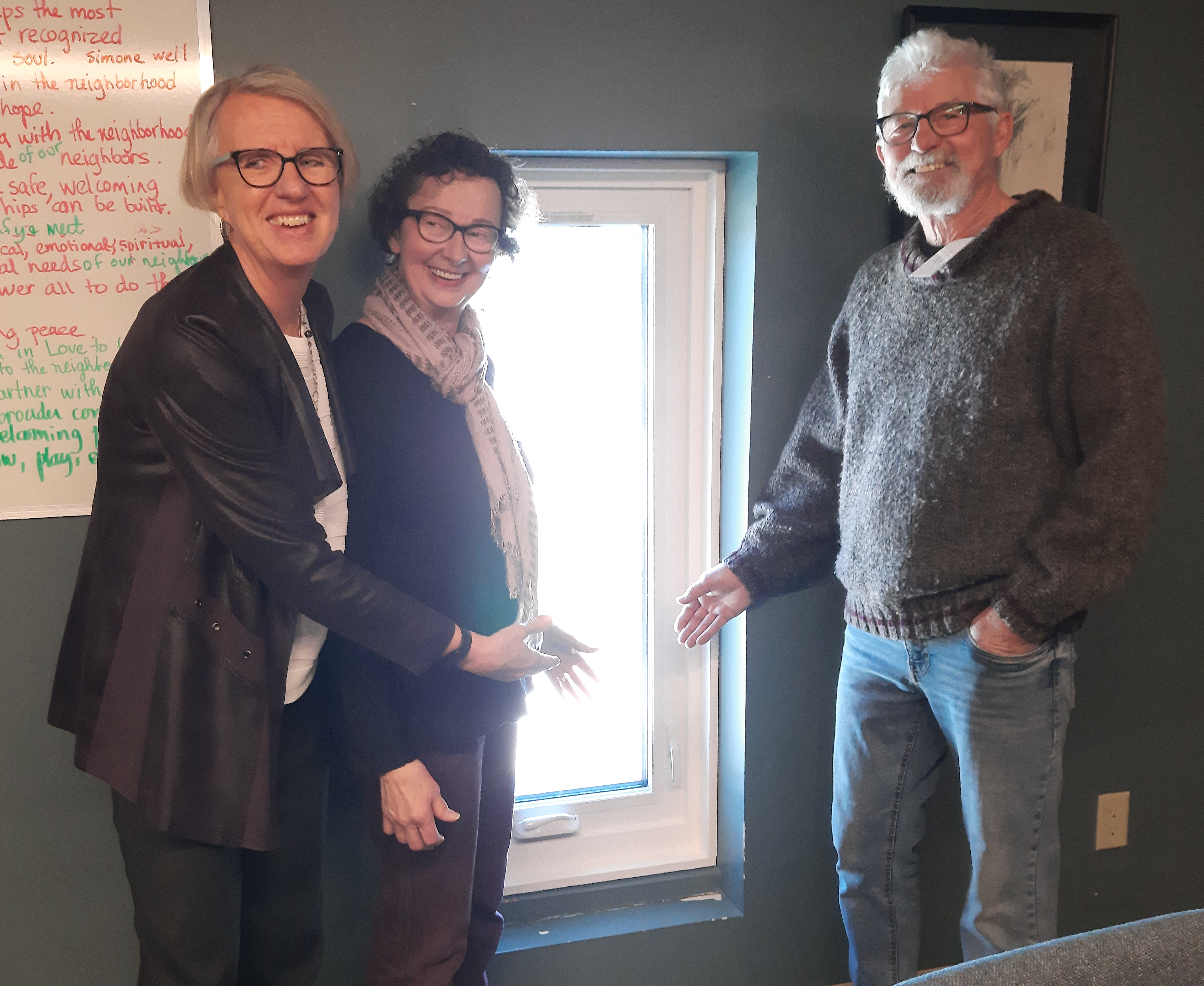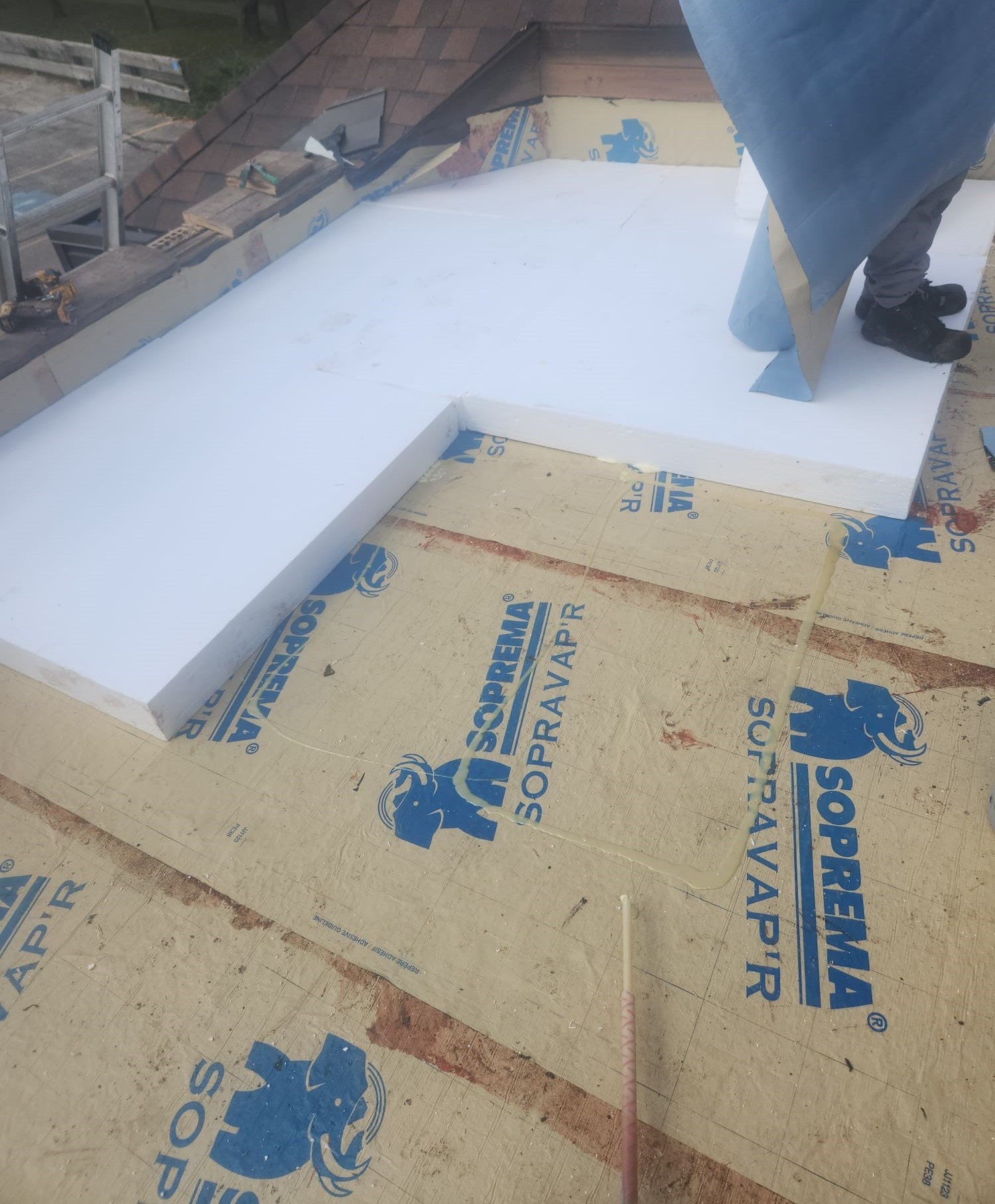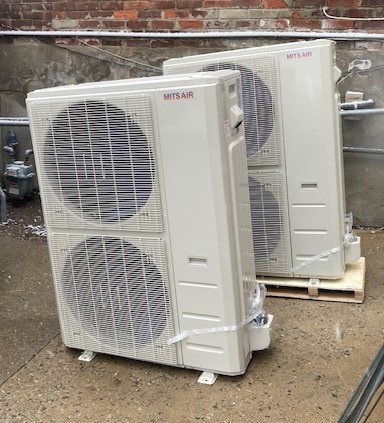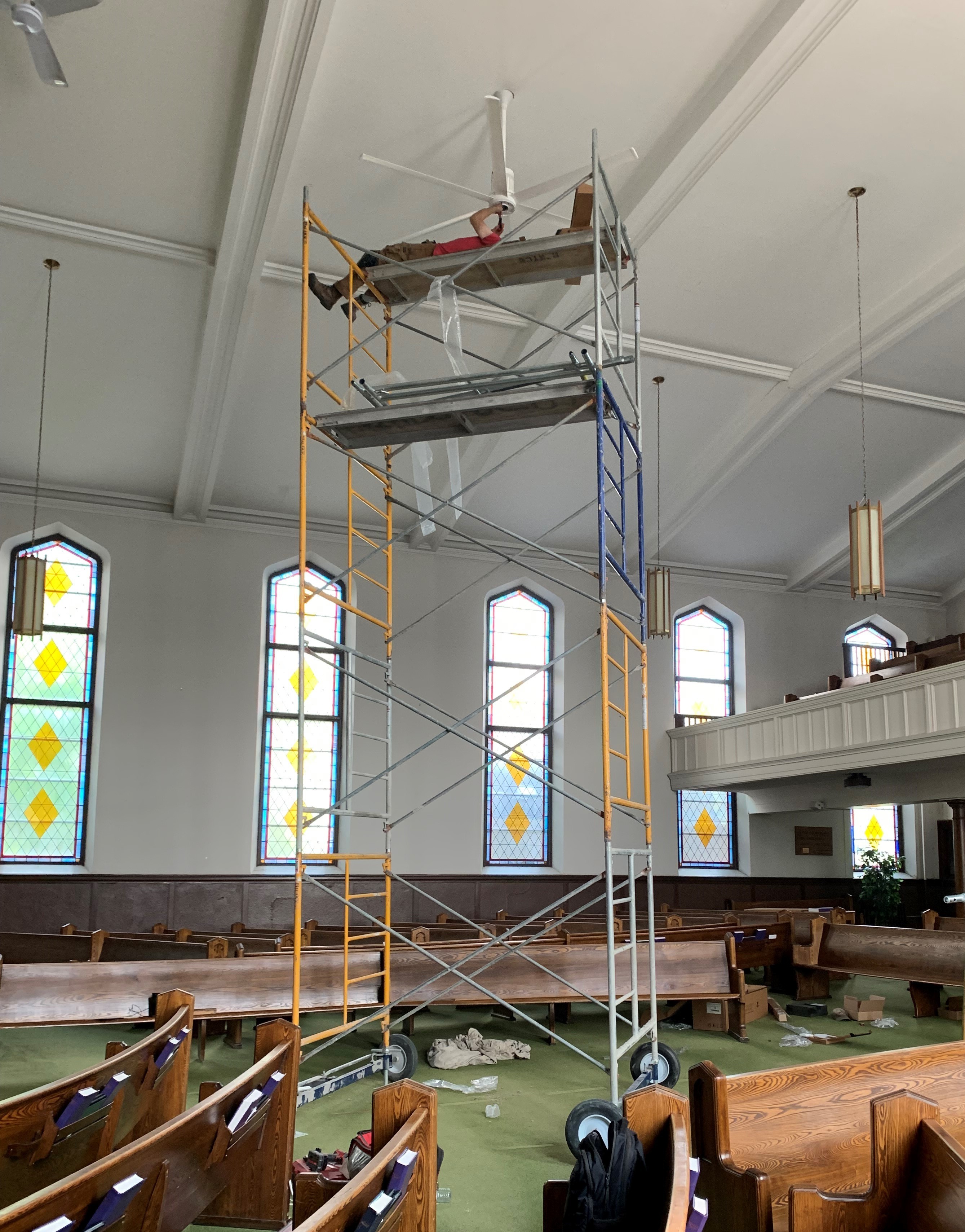August 27th, 2024Five more Emissions Reduction Grant Recipients Share Their Stories (updated)
In 2023, nine congregations received Emissions Reduction Grants from MC Canada to help offset costs related to reducing their carbon footprints. Five of those congregations share their progress in the stories below. (Four congregations previously shared their experiences - read here.)
- Jubilee Mennonite Church: Falling (and failing) windows
- Fort Garry Mennonite Fellowship (FGMF): Upgrading a roof
- Holyrood Mennonite Church: Stopping the draft(s)
- Toronto United Mennonite Church (TUMC): Pumping heat
- Home Street Mennonite Church: Pushing air
Jubilee Mennonite Church: Falling (and failing) windows (Read feature in Winnipeg Free Press)
Winnipeg – When opening a window in your house, you don’t expect it to fall out and smash into hundreds of shards on the ground below. But that’s exactly what happened at Viola Labun’s church.
 Labun, who is treasurer at Jubilee Mennonite Church in Winnipeg, expressed relief that no one was hurt.
Labun, who is treasurer at Jubilee Mennonite Church in Winnipeg, expressed relief that no one was hurt.
The falling window prompted an inspection of windows in the 50-year-old building, which revealed frames and sills at various stages of rot. The finding coincided with Labun reading about MC Canada’s Emissions Reduction Grant (ERG) in Canadian Mennonite magazine.
Experienced tradespeople and volunteers in the congregation replaced seven windows. The ERG helped cover part of the cost of the windows. Because of the urgency of the project, it had to begin before ERG funds came through.
"We're very thankful for that," Labun said, noting that many grants forbid the initiation of a project prior to fund dispersal.
Labun describes herself as a “numbers person,” who closely tracks the church’s utility bills. With a much warmer than usual winter in Winnipeg this year, she said it’s too soon to know if the new windows are saving energy.
An emissions survey of the congregation’s church building was part of the ERG application process. Labun took it a step further by organizing a three-week study series for an adult Sunday school class.
“It got us on to a conversation, which I thought was very good,” said Labun.
“The focus of our church has been on our building for the last couple of years,” she said, noting that the surrounding community heavily uses the facility.
A flooded basement caused about $50,000 damage in 2022. In anticipation of significant rain events in the future, the church re-landscaped the exterior of its building to ensure water flows away from the foundation. A summer student, enabled by a federal student employment grant, and volunteers, helped get the landscaping done.
In recent years, the congregation has made entrances and washrooms accessible to all, and installed a recyclable metal roof which has a much longer life span than a conventional shingled roof, said Labun. The church has planted trees on its large plot, which is home to a sizeable community garden and green space.
Diverse sources have provided significant funding for much of the building's improvements over the years.
“We’re pretty good at getting grants,” said Labun, referring to the church’s separately incorporated Community Roots Resource Centre (CRCC). With many at-risk and low income neighbours, the congregation sees needs in the community first hand. An energy efficient and low emissions building helps the congregation support nutrition and emergency food programs, children’s programs, healthy living activities such as yoga and art therapy, a family drop-in and coffee shop, various addiction recovery groups, and more.
Labun is grateful for the grants, but observes that the process takes effort. "All these grants come with work," she said, noting that work is involved in applications, reports, supervision, ensuring rules are followed, and the work of the projects themselves.
Plans in the congregation’s future involve a $25,000 project to improve attic insulation to reduce energy consumption. And their aging furnaces will need replacement soon.
Although the congregation does not have a formal emissions reduction strategy, they take climate into account as they improve their building. “In every decision we make, we take [the environment] into consideration,” said Labun.
“We’re very grateful to MC Canada for initiating [the ERG]. It encouraged us to have more dialogue than we would have otherwise. That’s our main message”.
Photo: Viola Labun (Treasurer), Margaret Froese (Facilities Committee Chair), and Walter Geddert, contractor. The new window replaces one that fell out of Jubilee Mennonite Church due to a rotting frame. The congregation replaced seven windows with the help of MC Canada’s Emissions Reduction Grant. Photo supplied
Fort Garry Mennonite Fellowship (FGMF): Upgrading a roof
 FGMF in south Winnipeg is progressing well in its emissions reduction journey. Recently, they added another project to their list of accomplishments: the congregation used its ERG to help offset significant costs of upgrading insulation in a flat part of its roof.
FGMF in south Winnipeg is progressing well in its emissions reduction journey. Recently, they added another project to their list of accomplishments: the congregation used its ERG to help offset significant costs of upgrading insulation in a flat part of its roof.
Ron Loeppky, who is on the facilities committee, said the lay-led congregation has already installed 56 solar panels on its roof, upgraded insulation, upgraded two of its four gas furnaces to more efficient models, and installed a heat recovery ventilation system.
They also planted Saskatoon berry bushes on its property as a means of greening their plot of land while providing a food source. A compact inner courtyard provides a micro-climate that’s beneficial for squash and other vegetables. Smaller things matter too: they use an electric lawn mower, offer household battery recycling, and compost organic matter.
Since the 1970s, FGMF has helped resettle over 100 refugees. Through a separate non-profit corporation, FGMF operates a semi-detached transition house to help resettle refugees and newcomers. The home has a high efficiency furnace and upgraded appliances.
The congregation’s Creation Care Committee studies wider environmental issues and considers meaningful changes for the future. They are gradually replacing compact fluorescent and incandescent lights with LED lighting as the older lamps fail.
Ongoing conversations include the future of energy sources for heating. “What do you do with the non-efficient furnaces? Do you put in a heat pump? These are the kinds of questions we’re currently discussing,” said Loeppky.
The suburban church building near the University of Manitoba campus offers its parking lot for nearby residents to use at non-peak times, and hosts seasonal recitals for music teachers and their students. The church provides space for language teaching programs run by Mennonite Central Committee (MCC), and hosts an MCC women’s quilting group.
The congregation stays well informed about its ongoing work in creation care. Solar panels on its roof testify to surrounding neighbours that the church is taking positive steps to reduce emissions.
“We appreciated the [ERG] a great deal and want Mennonite Church Canada to know that,” said Loeppky. “I like the emphasis that this is something our wider network of churches is being asked to work at.”
Photo: Fort Garry Mennonite Church significantly upgraded the insulation on a flat portion of its roof. Photo supplied.
Holyrood Mennonite Church: Stopping the drafts
Over in Edmonton, Margot Brunn, a trustee at Holyrood Mennonite Church, had planned to contract a professional energy audit. It ultimately proved too expensive for the cash-short congregation. Instead, members focused on improvements that were the most obviously needed in the 67-year-old building.
New weather stripping installed on the building’s exterior doors will reduce heat leakage. Finding seals and gaskets that fit their old steel clad doors proved a challenge, said Brunn. Other projects involve insulating hot water heaters and pipes, and upgrading two refrigerators to more energy efficient models. Brunn said their windows are in good condition.
To further reduce emissions, the exterior of the building needs additional insulation to reduce heating fuel consumption. Seven furnaces heat the building, all of which will need replacement, eventually. In the future, they hope to investigate additional grant opportunities to upgrade a flat portion of their roof, install solar panels, and possibly upgrade some furnaces to a heat pump. “That’s the dream,” said Brunn.
With weekly attendance at worship services in the range of 35-40 people, the small congregation helps support a Mennonite Voluntary Service unit, the Mennonite Central Committee Thrift Shop, and the Edmonton Mennonite Centre for Newcomers.
Having an energy efficient building in good repair is important to Holyrood. A 12-step program and a Spanish-speaking congregation rent space in the building, and there are tenants in two office spaces.
Since retiring, Brunn has lost many of the contacts and networks she used to rely on for knowledge and advice. It’s made sourcing available contractors and getting trustworthy advice a challenge.
She wonders if there might be knowledgeable volunteers in the wider Mennonite Church who could counsel those who are short on experience in property management.
She said, “It’s not necessarily the work [we need], but the advice.” She adds that a mentoring network would be helpful for congregations like Holyrood. Most in her congregation work in social and caregiving services, and don’t have expertise or experience in building maintenance.
“Drawing on a larger network of expertise would be really helpful for us as people learn how to do these things. We hope maybe there will be more specific kinds of sessions that we can all look into,” said Brunn.
Brunn said the online seminars on the topic of emissions reductions that were coordinated by Sandy Plett, Climate Action Coordinator for MC Canada, were very helpful. And she hopes other congregations receiving an ERG will share their learnings.
Toronto United Mennonite Church (TUMC): Pumping heat
The demise of a 25-year-old furnace signalled to TUMC that the building’s infrastructure needed attention. Replacing the furnace meant an unexpected, significant expense and no time window to consider low emission options for a replacement heating source. Fortunately, a congregant made a small interim fix, buying time for the property committee for longer range planning.
Though informal considerations for reducing emissions have been on their collective mind for some time, the congregation didn’t have a formal emissions reduction plan until the board approved an energy audit. A personal goal of Melana Janzen, property coordinator and a board member at TUMC, would be to meet or exceed the Paris Agreement targets of reducing emissions 45% by 2030 and reaching net zero by 2050.
 The church committed to replacing fossil fuel consuming appliances with equipment that emits less carbon as they age out. This spring they will upgrade part of their multi-unit heating and cooling system with a heat pump.
The church committed to replacing fossil fuel consuming appliances with equipment that emits less carbon as they age out. This spring they will upgrade part of their multi-unit heating and cooling system with a heat pump.
With government grants coming on stream for heat pumps, demands for cost estimates have exceeded supply. Janzen said it’s been a challenge to find contractors who have the time to assess TUMC’s building.
“It’s hard for people to tell if contractors know what they are doing, because some are just getting into the business [of heat pumps] and there’s a learning curve,” said Janzen, who is an architect.
Greening their energy consumption is important to TUMC. Toronto Mennonite New Life Church, a Spanish-speaking congregation, and the Mennonite New Life Centre of Toronto (MNLCT), a refugee and immigrant resettlement agency, use the building throughout the week.
TUMC also owns a nearby home which offers transitional housing to victims of human trafficking. Aurora House, a partnership with MNLCT, grew out of a TUMC’s refugee aid and resettlement ministry which has helped settle 160 individuals since the 1970s. The heating system in the house is “… efficient for its time, but it’s not really aging out yet,” said Janzen.
Future plans include upgrading older refrigerators and replacing a gas stove in the kitchen. The congregation plans to replace the remaining heating and cooling units with low emissions options as they age out.
TUMC will communicate their values, goals, commitments, and achievements regarding creation care on a page of their church’s web site. They already have a recycling and composting program, and use programmable thermostats to reduce heating and cooling emissions during off-hours.
“We also do advocacy, go to protests, and have done letter-writing campaigns advocating for creation care in general,” said Janzen. Internal efforts and events encourage personal responsibility for creation care through worship, potlucks, meatless meals, car-pooling and bike-to-church Sundays.
Update, March 22, 2024: TUMC’s heat pumps arrived and have been installed.
Home Street Mennonite Church: Pushing air
Home Street Mennonite Church has a prime location at the western edge of downtown Winnipeg. But being in a building that’s more than a century old can be both a blessing and a burden, said David Neufeld, coordinator of the Facilities Team. Neufeld is a senior manager in the department of municipal and northern relations for the province of Manitoba, and has environmental sustainability in his DNA. In the past, he served as a long-time member of the Mennonite Creation Care Network.
A significant portion of the congregation live within walking or cycling distance of the church, a good thing that helps reduce car use. The location is easily accessible to food bank users in the community: on Wednesdays, volunteers help distribute food in partnership with the Winnipeg Harvest foodbank. Worship services regularly incorporate themes of creation care.
The congregation has committed to staying in its building and location. “Home Street wouldn’t be Home Street if it were anywhere else,” said Neufeld. A major project about a decade ago involved completely new washrooms with low flush toilets and motion activated lighting, and a new elevator to make the building accessible to all.
In 2020, they contracted with Faith & The Common Good, which conducted a green audit of the church building. The audit prompted upgrades from incandescent lighting to LED or equivalent lighting in its fellowship hall, kitchen and sanctuary, improved weather stripping, moved to greener cleaning products, and replaced an old fridge.
“We’ve picked the low-hanging fruit,” said Neufeld, referring to changes made so far. But reducing bigger sources of carbon emissions, such as from its gas-fired heating system, represents a conundrum for managers of the old building.
An ancient fuel guzzling steam boiler heats the facility, which has a seating capacity of 500 people in its sanctuary. The steam pipes and radiators are rusting and getting less efficient. Replacing the heating system could cost more than $400,000, said Neufeld. “With a little luck, we might have five to seven years left in that system, but the price tag is high, no matter what,” said Neufeld.
Another complication is attic insulation. Loose insulation added over the years reduces heat loss, but flusters the natural ventilation flow designed into the building. With no air conditioning and poor air flow, the high-ceilinged building retains a lot of hot air in the summer.
 The proposed solution is one or two large, energy efficient fans installed in the ceiling to replace two, noisy and small older fans. The upgrade will be much quieter and will help restore sorely needed air circulation in the main sanctuary in all seasons. The unit will also improve comfort for occupants during the heating season by pushing warmer air down to the floor level. “We’ll save electricity, and move the air a lot better,” said Neufeld.
The proposed solution is one or two large, energy efficient fans installed in the ceiling to replace two, noisy and small older fans. The upgrade will be much quieter and will help restore sorely needed air circulation in the main sanctuary in all seasons. The unit will also improve comfort for occupants during the heating season by pushing warmer air down to the floor level. “We’ll save electricity, and move the air a lot better,” said Neufeld.
The ERG will help cover most or all of the fan cost, but labour fees for installation could be four to five times the purchase price, said Neufeld. That’s if he is successful in finding tradespeople to do the work. He’s reached out to several installers. “We’ve managed to have one come out to the building,” said Neufeld. He speculates that contractors are extremely busy, and the height of the church’s ceiling presents technical challenges. (Update: fans are being installed; picture)
Neufeld said that the congregation is committed to staying in its building and that “nothing is off the table” for reducing its carbon footprint. Home Street’s building has a large, elevated section of south facing roof, making it ideal for solar panels. Experts estimate that a solar panel array for the building will return its investment in 30 years. It’s a long time, but “It’s not something we’re ruling out,” he said.
The congregation’s climate action group strongly encourages cycling to church. They propose enhanced bike security, free bike tune-ups in spring, and a car pooling map. “We just did a vegan potluck to flag the fact that we’re often using a carbon intensive diet,” said Neufeld, who attends the climate action group’s meetings when he can.
Political advocacy for reduced fossil fuel consumption, coffee houses to educate attenders on climate justice through the arts, and encouraging members to donate all or part of their carbon tax rebates to the church’s climate fund round out some of the congregation’s additional initiatives. An idea that hasn’t yet gotten off the ground is a community exchange of member services, goods, and talents -- an effort to reduce consumer purchases of new products.
“Home Street has demonstrated more than a superficial interest in [climate justice]. It’s one of those things we see as part of our Christian witness,” said Neufeld.
He adds that “We’re certainly appreciative of MC Canada’s leadership in this. We think that MC Canada is making a difference here.”
Photo: Ceiling fans are being installed. Photo supplied.